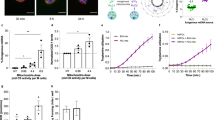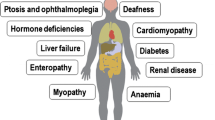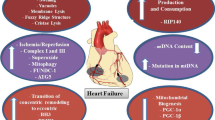Abstract
Mitochondria transfer is a recently described phenomenon in which donor cells deliver mitochondria to acceptor cells1,2,3. One possible consequence of mitochondria transfer is energetic support of neighbouring cells; for example, exogenous healthy mitochondria can rescue cell-intrinsic defects in mitochondrial metabolism in cultured ρ0 cells or Ndufs4−/− peritoneal macrophages4,5,6,7. Exposing haematopoietic stem cells to purified mitochondria before autologous haematopoietic stem cell transplantation allowed for treatment of anaemia in patients with large-scale mitochondrial DNA mutations8,9, and mitochondria transplantation was shown to minimize ischaemic damage to the heart10,11,12, brain13,14,15 and limbs16. However, the therapeutic potential of using mitochondria transfer-based therapies to treat inherited mitochondrial diseases is unclear. Here we demonstrate improved morbidity and mortality of the Ndufs4−/− mouse model of Leigh syndrome (LS) in multiple treatment paradigms associated with mitochondria transfer. Transplantation of bone marrow from wild-type mice, which is associated with release of haematopoietic cell-derived extracellular mitochondria into circulation and transfer of mitochondria to host cells in multiple organs, ameliorates LS in mice. Furthermore, administering isolated mitochondria from wild-type mice extends lifespan, improves neurological function and increases energy expenditure of Ndufs4−/− mice, whereas mitochondria from Ndufs4−/− mice did not improve neurological function. Finally, we demonstrate that cross-species administration of human mitochondria to Ndufs4−/− mice also improves LS. These data suggest that mitochondria transfer-related approaches can be harnessed to treat mitochondrial diseases, such as LS.
Access this article
We’re sorry, something doesn't seem to be working properly.
Please try refreshing the page. If that doesn't work, please contact support so we can address the problem.




Similar content being viewed by others
Data availability
All data supporting the findings of this study are available within the paper and its Supplementary Information or are available by request to the corresponding authors. MRC-Q is a proprietary, unique biological material and its use is restricted by a material transfer agreement. MRC-Q is available upon request from LUCA Science. Source data are provided with this paper.
References
Al Amir Dache, Z. & Thierry, A. R. Mitochondria-derived cell-to-cell communication. Cell Rep. 42, 112728 (2023).
Zhu, M. et al. Mitochondria released by apoptotic cell death initiate innate immune responses. Immunohorizons 2, 384–397 (2018).
Borcherding, N. & Brestoff, J. R. The power and potential of mitochondria transfer. Nature 623, 283–291 (2023).
Borcherding, N. et al. Dietary lipids inhibit mitochondria transfer to macrophages to divert adipocyte-derived mitochondria into blood. Cell Metab. 34, 1499–1513.e8 (2022).
Spees, J. L., Olson, S. D., Whitney, M. J. & Prockop, D. J. Mitochondrial transfer between cells can rescue aerobic respiration. Proc. Natl Acad. Sci. USA 103, 1283–1288 (2006).
Kim, M. J., Hwang, J. W., Yun, C.-K., Lee, Y. & Choi, Y.-S. Delivery of exogenous mitochondria via centrifugation enhances cellular metabolic function. Sci. Rep. 8, 3330 (2018).
Caicedo, A. et al. MitoCeption as a new tool to assess the effects of mesenchymal stem/stromal cell mitochondria on cancer cell metabolism and function. Sci. Rep. 5, 9073 (2015).
Jacoby, E. et al. Mitochondrial augmentation of hematopoietic stem cells in children with single large-scale mitochondrial DNA deletion syndromes. Sci. Transl. Med. 14, eabo3724 (2022).
Jacoby, E. et al. Mitochondrial augmentation of CD34+ cells from healthy donors and patients with mitochondrial DNA disorders confers functional benefit. NPJ Regen. Med. 6, 58 (2021).
Masuzawa, A. et al. Transplantation of autologously derived mitochondria protects the heart from ischemia-reperfusion injury. Am. J. Physiol. Heart Circ. Physiol. 304, H966–H982 (2013).
McCully, J. D. et al. Injection of isolated mitochondria during early reperfusion for cardioprotection. Am. J. Physiol. Heart Circ. Physiol. 296, H94–H105 (2009).
Emani, S. M., Piekarski, B. L., Harrild, D., Nido, P. J. D. & McCully, J. D. Autologous mitochondrial transplantation for dysfunction after ischemia-reperfusion injury. J. Thorac. Cardiovasc. Surg. 154, 286–289 (2017).
Hayakawa, K. et al. Protective effects of endothelial progenitor cell-derived extracellular mitochondria in brain endothelium. Stem Cells 36, 1404–1410 (2018).
Hayakawa, K. et al. Transfer of mitochondria from astrocytes to neurons after stroke. Nature 535, 551–555 (2016).
Norat, P. et al. Intraarterial transplantation of mitochondria after ischemic stroke reduces cerebral infarction. Stroke Vasc. Interv. Neurol. 3, e000644 (2023).
Lin, R. Z. et al. Mitochondrial transfer mediates endothelial cell engraftment through mitophagy. Nature 629, 660–668 (2024).
Diodato, D. et al. 258th ENMC international workshop Leigh syndrome spectrum: genetic causes, natural history and preparing for clinical trials 25–27 March 2022, Hoofddorp, Amsterdam, The Netherlands. Neuromuscul. Disord. https://doi.org/10.1016/j.nmd.2023.06.002 (2023).
Sofou, K. et al. A multicenter study on Leigh syndrome: disease course and predictors of survival. Orphanet J. Rare Dis. 9, 52 (2014).
McCormick, E. M. et al. Expert panel curation of 113 primary mitochondrial disease genes for the Leigh syndrome spectrum. Ann. Neurol. 94, 696–712 (2023).
Kruse, S. E. et al. Mice with mitochondrial complex I deficiency develop a fatal encephalomyopathy. Cell Metab. 7, 312–320 (2008).
Pham, A. H., McCaffery, J. M. & Chan, D. C. Mouse lines with photo-activatable mitochondria to study mitochondrial dynamics. Genesis 50, 833–843 (2012).
Brestoff, J. R. et al. Intercellular mitochondria transfer to macrophages regulates white adipose tissue homeostasis and is impaired in obesity. Cell Metab. 33, 270–282.e8 (2021).
Boudreau, L. H. et al. Platelets release mitochondria serving as substrate for bactericidal group IIA-secreted phospholipase A2 to promote inflammation. Blood 124, 2173–2183 (2014).
Dache, Z. A. A. et al. Blood contains circulating cell-free respiratory competent mitochondria. FASEB J. 34, 3616–3630 (2020).
Crewe, C. et al. Extracellular vesicle-based interorgan transport of mitochondria from energetically stressed adipocytes. Cell Metab. 33, 1853–1868.e11 (2021).
van der Vlist, M. et al. Macrophages transfer mitochondria to sensory neurons to resolve inflammatory pain. Neuron 110, 613–626.e9 (2022).
Machado, T. S. et al. Real-time PCR quantification of heteroplasmy in a mouse model with mitochondrial DNA of C57BL/6 and NZB/BINJ strains. PLoS ONE 10, e0133650 (2015).
Court, A. C. et al. Mitochondrial transfer from MSCs to T cells induces Treg differentiation and restricts inflammatory response. EMBO Rep. 21, e48052 (2020).
Luz-Crawford, P. et al. Mesenchymal stem cell repression of Th17 cells is triggered by mitochondrial transfer. Stem Cell Res. Ther. 10, 232 (2019).
Wu, B. et al. Mitochondrial aspartate regulates TNF biogenesis and autoimmune tissue inflammation. Nat. Immunol. 22, 1551–1562 (2021).
Peruzzotti-Jametti, L. et al. Neural stem cells traffic functional mitochondria via extracellular vesicles. PLoS Biol. 19, e3001166 (2021).
Stokes, J. C. et al. Leukocytes mediate disease pathogenesis in the Ndufs4(KO) mouse model of Leigh syndrome. JCI Insight https://doi.org/10.1172/jci.insight.156522 (2022).
Jin, Z., Wei, W., Yang, M., Du, Y. & Wan, Y. Mitochondrial complex I activity suppresses inflammation and enhances bone resorption by shifting macrophage-osteoclast polarization. Cell Metab. 20, 483–498 (2014).
Yu, A. K. et al. Mitochondrial complex I deficiency leads to inflammation and retinal ganglion cell death in the Ndufs4 mouse. Hum. Mol. Genet. 24, 2848–2860 (2015).
Yoon, Y. G., Haug, C. L. & Koob, M. D. Interspecies mitochondrial fusion between mouse and human mitochondria is rapid and efficient. Mitochondrion 7, 223–229 (2007).
Jain, I. H. et al. Leigh Syndrome Mouse Model Can Be Rescued by Interventions that Normalize Brain Hyperoxia, but Not HIF Activation. Cell Metab. 30, 824–832.e3 (2019).
McElroy, G. S. et al. NAD+ regeneration rescues lifespan, but not ataxia, in a mouse model of brain mitochondrial complex I dysfunction. Cell Metab. 32, 301–308.e6 (2020).
Lee, C. F., Caudal, A., Abell, L., Nagana Gowda, G. A. & Tian, R. Targeting NAD+ metabolism as interventions for mitochondrial disease. Sci. Rep. 9, 3073 (2019).
Ball, M., Thorburn, D. R. & Rahman, S. in GeneReviews (eds Adam, M. P. et al.) 1993–2024 (Univ. Washington, 2003).
Daemen, S., Chan, M. M. & Schilling, J. D. Comprehensive analysis of liver macrophage composition by flow cytometry and immunofluorescence in murine NASH. STAR Protoc. 2, 100511 (2021).
Acknowledgements
Funding for this study was provided by the National Institute of Neurological Disorders and Stroke award 1R01NS134932 (to J.R.B.), Burroughs Wellcome Fund Career Award for Medical Scientists no. 1019648 (to J.R.B.) and a Grant-in-Aid for Scientific Research (C) 21K08415 (to T.Y.). Additional support was provided by the Japanese Society of Hematology (to R.N.), JST SPRING JPMJSP no. 2138 (to R.N.), the Japan Society for the Promotion of Science KAKENHI 20K17379 (to R.N.) and 22K16322 (to R.N.), American Heart Association (AHA) Predoctoral Fellowship 24PRE1189775 (to R.G.), AHA Postdoctoral Fellowship 24POST1244220 (to W.J.), W.M. Keck Foundation Fellowship in Molecular Medicine (to S.J.K.), a Washington University BioSURF grant (to E.F.C.) and National Institutes of Health (NIH) 5U54-NS078059-12 (to R.P.S.). We thank LUCA Science staff T. Shibata for developing the MRC-Q isolation method, J. Hayashi for providing MRC-Q materials and Y. El-Darawish for developing methods. Experimental design schematics in Figs. 1a, 2a, 3a,f,h and 4d were created with BioRender.com.
Author information
Authors and Affiliations
Contributions
R.N. and S.V. performed experiments, analysed data, interpreted results and wrote the manuscript. R.L.F., H.S., R.G., W.J., S.J.K., E.F.C. and N.B. performed experiments, analysed data and interpreted results. R.P.S. provided scientific guidance and interpreted results. R.C.T., M.S. and H.O. gave scientific guidance, provided essential reagents, performed experiments and interpreted results. T.Y. and J.R.B. conceived of the project, secured funding, performed experiments, interpreted results and wrote the manuscript. All authors contributed to writing, editing and/or revising this manuscript and approved the final version.
Corresponding authors
Ethics declarations
Competing interests
R.C.T., H.O. and M.S. are employees of LUCA Science and are inventors on patents and/or pending patents related to MRC-Q (WO2024010862, WO2024010866). J.R.B. has pending patent applications related to the treatment of obesity (63/625,555) and allergic diseases (US20210128689A1), is a consultant for Columbus Instruments, has been a consultant for DeciBio in the past 12 months, is a member of the Scientific Advisory Board for LUCA Science, receives research support from LUCA Science for a project unrelated to this paper and receives royalties from Springer Nature Group. J.R.B., N.B. and R.L.F. are inventors of technology (Clambake) licensed to Columbus Instruments, which is not used in this paper. N.B. was employed by Omniscope within the past 12 months and holds equity in this company. R.P.S. receives research funding from Astellas (0367-CL-1201) that is unrelated to this paper. R.N. and T.Y. receive research support from LUCA Science. All other authors declare no competing interests.
Peer review
Peer review information
Nature Metabolism thanks Alessandro Bitto, Anne-Marie Rodriguez and the other, anonymous, reviewer(s) for their contribution to the peer review of this work. Primary Handling Editor: Christoph Schmitt, in collaboration with the Nature Metabolism team.
Additional information
Publisher’s note Springer Nature remains neutral with regard to jurisdictional claims in published maps and institutional affiliations.
Extended data
Extended Data Fig. 1 Additional metabolic cage parameters from NDUFS4-deficient mice treated with wildtype or NDUFS4-deficient bone marrow transplantation.
(a) Distance travelled and (b) average respiratory exchange ratio (RER) over 3 hr after a 1 hr air equilibration period. Data are expressed as mean +/− SEM. All data points are unique biological replicates. n = 5 KO, n = 17 WT. Data accompanies Fig. 1.
Extended Data Fig. 2 Engraftment of CD45.1+ cells in blood, spleen, and liver in mice transplanted with wildtype or mtD2 bone marrow.
(a) Representative gating for identification of CD45.1+ CD45.2− donor immune cells and CD45.1− CD45.2+ radioresistant host cells. (b) Chimerism expressed as a percentage of the ratio of CD45.1+ cells to the sum of CD45.1+ and CD45.2+ cells. (c) Representative gating in the blood to exclude red blood cells (RBCs) and platelets from particles less than 2 µm in diameter for identification of extracellular mtD2+ mitochondria. Data are expressed as mean +/− SEM. All data points are unique biological replicates. For b, n = 3 WT, n = 5 mtD2 (except n = 4 for spleen). Data accompanies Fig. 2.
Extended Data Fig. 3 Bone marrow transplantation leads to transfer of mtD2+ mitochondria to host cells in the blood, spleen, and liver.
(a) Representative gating for identification of CD45.1− CD45.2+ radioresistant host B cells, T cells, neutrophils, and monocytes as well as CD45.1− CD45.2− host epithelial, endothelial, and stromal cells in the spleen. (b) Representative gating to identify the proportions of host B cells, T cells, neutrophils, monocytes, epithelial, endothelial, and stromal cells that received mtD2+ mitochondria in the spleen. (c) Proportions of B cells (B), T cells (T), neutrophils (neut), monocytes (mono), epithelial cells (epi), endothelial cells (endo), and stromal cells that received mtD2+ mitochondria in the liver and (d) peripheral blood. For c-d, closed circles are WT and open squares are mtD2. Data are expressed as mean +/− SEM. All data points are unique biological replicates. For b-d, n=3 WT, n=5 mtD2 (except n=4 for spleen). For b-d, 2-way ANOVA with Sidak post-hoc test. ***P<0.001, ****P<0.0001. Data accompanies Fig. 2.
Extended Data Fig. 4 Mitochondria isolates from the liver are enriched in mtD2+ events and produce more yield than bone marrow mitochondria isolates.
(a) Flow cytometric identification of the proportion of mtD2+ mitochondria. Pre-gated on CD41− CD45− TER-119− events less than 2 µm in diameter. (b) Mitochondrial yield from mouse liver or bone marrow (BM). Data are expressed as mean +/− SEM. All data points are unique biological replicates. For a-b, n=4 biological replicates/group. For b, Student’s t-test (two-sided). *P<0.05 Data accompanies Fig. 3.
Extended Data Fig. 5 Additional metabolic cage parameters from NDUFS4-deficient mice treated with mitochondria or PBS.
(a) Body weight, and (b) rectal core body temperature of 7-week-old KO mice treated with PBS or 100 µg mitochondria 1-2 times per week. (c) Average energy expenditure (d) distance travelled, and (e) average respiratory exchange ratio (RER) over 3 hr after a 1 hr air equilibration period. Data are expressed as mean +/− SEM. All data points are unique biological replicates. For a, n = 11 PBS, n = 12 WT. For b, n = 11/group. For c-e, n = 15/group. Variation in n is due to mouse mortality. For c, Student’s t-test (two-sided). *P < 0.05. Data accompanies Fig. 3.
Extended Data Fig. 6 Administration of wildtype mitochondria to NDUFS4-deficient mice does not alter immune cell composition in the blood.
(a) Representative gating to identify immune cells in the peripheral blood of Ndufs4−/− (KO) mice. (b) Overall number of B cells (B), eosinophils (eos), natural killer cells (NK), neutrophils (neut), monocytes (mono), CD4 T cells, and CD8 T cells per mL of peripheral blood from KO mice treated weekly with PBS (closed circle) or 100µg mitochondria (open square) for 5 weeks. Data are expressed as mean +/− SEM. All data points are unique biological replicates. For b, n=14 PBS, n=18 Mito. For b, 2-way ANOVA with Sidak post-hoc test. Data accompanies Fig. 3.
Extended Data Fig. 7 Administration of mitochondria to NDUFS4-deficient mice does not alter immune cell composition in the blood or tissues.
(a) Overall number of immune cells in peripheral blood, (b) spleen, (c) bone marrow, and (d) liver of Ndufs4−/− mice treated weekly with 100µg KO or WT mitochondria for 7 weeks. For a-d, closed circles are KO mito and open squares are WT mito. Data are expressed as mean +/− SEM. All data points are unique biological replicates. For a, n=3 KO Mito, n=4 WT Mito. For b and d, n=4/group. For c, n=4 KO Mito, n=3 WT Mito. For a-d, 2-way ANOVA with Sidak post-hoc test. Data accompanies Fig. 3.
Extended Data Fig. 8 Administration of mitochondria to NDUFS4-deficient mice does not alter expression of inflammatory cytokines.
(a) Inflammatory cytokine expression in the spleen (b) peritoneal exudate cells (PECS), and (c) liver of Ndufs4−/− mice treated weekly with 100µg KO or WT mitochondria for 7 weeks. For a-c, closed circles are KO mito and open squares are WT mito. Data are expressed as mean +/− SEM. All data points are unique biological replicates. For a-c, n=4 biological replicates/group. For a-c, 2-way ANOVA with Sidak post-hoc test. Data accompanies Fig. 3.
Extended Data Fig. 9 Administration of MRC-Q does not alter body weight in NDUFS4-deficient mice.
Body weight of Ndufs4−/− mice treated with PBS or 50 µg MRC-Q once per week from 3- to 7-weeks old. Data are expressed as mean +/− SEM. All data points are unique biological replicates. n = 12 PBS, n = 14 MRC-Q. Data accompanies Fig. 4.
Supplementary information
Supplementary Video 1
Treatment of Ndufs4−/− mice with exogenous mitochondria leads to improved hair regrowth and improved neurobehavioural characteristics. Mice were treated once per week with PBS (left cage) or 100 µg Mito (right cage).
Supplementary Video 1
Administration of MRC-Q improves righting reflex in Ndufs4−/−mice. Mice were treated once a week with PBS (right cage) or 50 µg MRC-Q (left cage).
Supplementary Video 3
Administration of MRC-Q improves tail suspension stability and landing recovery in Ndufs4−/− mice. Mice were treated once a week with PBS (right cage) or 50 µg MRC-Q (left cage).
Source data
Source Data Fig. 1
Statistical source data.
Source Data Fig. 2
Statistical source data.
Source Data Fig. 3
Statistical source data.
Source Data Fig. 4
Statistical source data.
Source Data Extended Data Fig. 1
Statistical source data.
Source Data Extended Data Fig. 2
Statistical source data.
Source Data Extended Data Fig. 3
Statistical source data.
Source Data Extended Data Fig. 4
Statistical source data.
Source Data Extended Data Fig. 5
Statistical source data.
Source Data Extended Data Fig. 6
Statistical source data.
Source Data Extended Data Fig. 7
Statistical source data.
Source Data Extended Data Fig. 8
Statistical source data.
Source Data Extended Data Fig. 9
Statistical source data.
Rights and permissions
Springer Nature or its licensor (e.g. a society or other partner) holds exclusive rights to this article under a publishing agreement with the author(s) or other rightsholder(s); author self-archiving of the accepted manuscript version of this article is solely governed by the terms of such publishing agreement and applicable law.
About this article
Cite this article
Nakai, R., Varnum, S., Field, R.L. et al. Mitochondria transfer-based therapies reduce the morbidity and mortality of Leigh syndrome. Nat Metab (2024). https://doi.org/10.1038/s42255-024-01125-5
Received:
Accepted:
Published:
DOI: https://doi.org/10.1038/s42255-024-01125-5
- Springer Nature Limited





